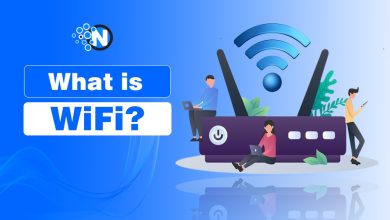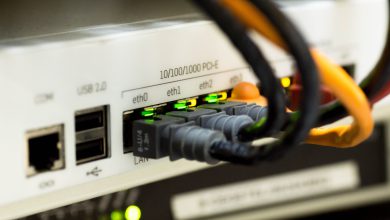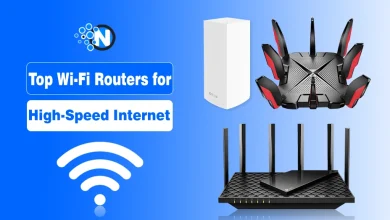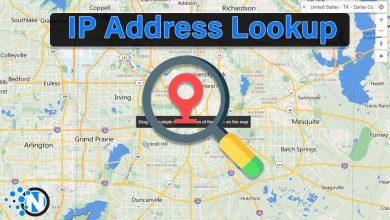Types of Internet (Explained 2025)
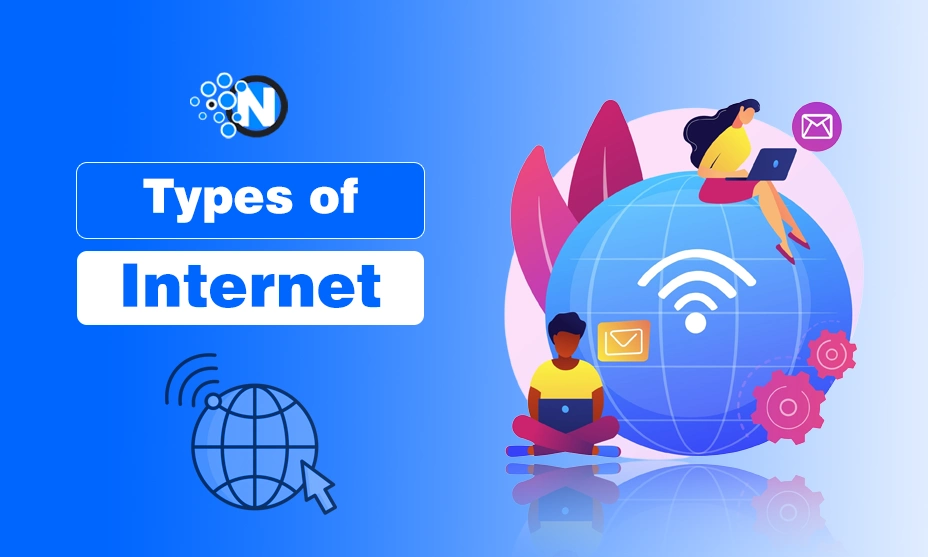
Struggling to find the best internet connection for your needs?
Are you tired of slow speeds, buffering while streaming, or unreliable connections while gaming or working from home? Do you find yourself wondering which internet service is the best fit for your lifestyle? You’re not alone! With so many internet options available today, choosing the right one can be confusing.
But don’t worry! In this guide, I will break down the different types of internet connections available in 2025. Whether you need ultra-fast fiber, widespread DSL, or a reliable mobile network, I have got you covered.
Top 8 Types of Internet
In the under section, I have explained the top 8 types of Internet that are widely popular in the year 2025.
1. Dial-Up Internet
Dial-up internet was one of the earliest forms of internet access and remains available in some remote areas. It works by using a telephone line and a modem, which dials into an Internet Service Provider (ISP) to establish a connection. Unlike modern broadband services, dial-up internet can only provide speeds of up to 56 kbps.
Additionally, dial-up has a significant limitation. It cannot be used while making phone calls since it relies on the same telephone line. This means that every time a user needs to access the internet, they must temporarily disconnect their telephone service.
Best For
- Users in extremely remote areas with no other internet options
- Those who need only basic internet access for text-based browsing
Pros
- Extremely cheap compared to modern broadband options
- Available in areas where no other internet options exist
Cons
- Very slow speeds that cannot handle modern websites, streaming, or gaming
- Disconnects whenever the telephone line is in use
- No longer a practical option for most users
Which Companies Offer?
Dial Up Internet is no longer available as it is not effective enough to meet the demands of the modern world. However, NetZero and Juno are still offering it.
Read More: The Internet of Things (IoT) and Its Implications for the Future
2. DSL (Digital Subscriber Line) Internet
DSL is an upgraded version of dial-up internet that still relies on telephone lines but operates on a different frequency. As a result, it allows internet access without interrupting phone service. Unlike dial-up, DSL offers significantly faster speeds, ranging from 1 Mbps to 100 Mbps, depending on the provider and location.
DSL connections are widely available, especially in suburban and rural areas where fiber-optic infrastructure has not been reached yet. The performance of DSL, however, depends on how far a user is from the provider’s central office. The farther the distance, the weaker the signal and the slower the internet speed.
Best For
- Households that need an affordable internet option
- Users who require moderate speeds for browsing and light streaming
Pros
- More reliable than dial-up and available in many locations
- Affordable broadband option
- Can support basic streaming and browsing needs
Cons
- Speed drops significantly with increased distance from the provider
- Not ideal for high-definition streaming, gaming, or large file downloads
Which Companies Offer?
Companies like CenturyLink, Kinetic by Windstream, and Verizon are offering the DSL internet connection.
3. Cable Internet
Cable internet is delivered using coaxial cables, the same ones used for cable TV services. It offers much faster speeds than DSL. Usually, it ranges from 50 Mbps to 1 Gbps, which makes it one of the most popular internet choices for homes and businesses.
One of the biggest advantages of cable internet is that it provides stable and consistent speeds. Hence, it is a great option for families, remote workers, and gamers. However, because it is a shared connection, multiple users in the same neighborhood can experience slowdowns during peak usage hours.
Best For
- Homes and businesses requiring reliable and fast internet
- Gamers, streamers, and professionals working from home
Pros
- Faster than DSL and widely available
- Suitable for heavy streaming, gaming, and multiple devices
- More stable than DSL
Cons
- Speed slows down during peak hours due to shared bandwidth
- Slightly more expensive than DSL
Which Companies Offer?
In the United States, Spectrum, Xfinity (Comcast), Optimum, Cox, and WOW are the top companies for providing Cable Internet connections.
4. Fiber-Optic Internet
Fiber-optic internet is the fastest and most reliable form of internet available today. It uses fiber-optic cables made of thin glass or plastic fibers to transmit data as light signals. This allows for ultra-fast speeds ranging from 1 Gbps to 10 Gbps, with virtually no interference or slowdowns for better and safer internet use.
Unlike DSL or cable, fiber-optic connections do not degrade over distance. So, if you are biased towards high speed internet, fiber optic is the best solution for you. The downside is that fiber-optic infrastructure is expensive and still not available in all areas.
Best For
- Gamers and streamers who need the fastest speeds
- Large households with multiple devices connected at once
- Professionals working with high-bandwidth applications
Pros
- Lightning-fast speeds with ultra-low latency
- No slowdowns, even during peak usage times
- Ideal for gaming, video conferencing, and smart home devices
Cons
- More expensive than cable or DSL
- Limited availability in rural areas
Which Companies Offer?
AT&T, Google Fiber, and Frontier are the major fiber-optic internet providers in the United States.
5. Satellite Internet
Satellite internet is an option for users in remote or rural areas where traditional broadband services are unavailable. It works by transmitting internet signals from satellites in orbit to a dish installed at the user’s location.
While satellite internet can offer speeds up to 200 Mbps, it suffers from high latency due to the long distance that data must travel between Earth and the satellite. This makes it less ideal for gaming, video calls, or real-time applications.
Best For
- Users in remote areas with no fiber, DSL, or cable access
- Basic browsing and occasional streaming
Pros
- Available in areas with no other broadband options
- Can deliver moderate speeds suitable for web browsing
Cons
- High latency affects gaming and video calls
- Expensive and often comes with data limits
Which Companies Offer?
In 2025, the main satellite internet providers in the USA are Starlink, Viasat, and Hughesnet.
6. 5G Internet
5G is the latest advancement in wireless broadband technology. It delivers ultra-fast internet speeds of up to 10 Gbps with incredibly low latency. 5G networks are expanding globally and are becoming a game-changer for mobile connectivity, smart cities, and even home broadband.
With its fast speed and seamless connectivity, you can get the most out of the Internet in your daily life and reach to the top by enhancing productivity.
Best For
- Users who need high-speed wireless internet
- Gamers and streamers requiring low-latency connections
Pros
- Ultra-fast speeds and low latency
- No need for wired infrastructure
- Expanding coverage worldwide
Cons
- Limited availability in some areas
- Requires a 5G-compatible device
Which Companies Offer?
Verizon, T-Mobile, and Starry Internet are the major companies that are offering 5G internet connectivity in the US.
7. Fixed Wireless Internet
Fixed wireless internet delivers broadband using radio signals from a nearby tower to a receiver installed at the user’s location. This makes it one of the best types of Internet options for rural areas that lack fiber or cable infrastructure.
Speeds can range from 10 Mbps to 1 Gbps, depending on the provider and signal quality. However, fixed wireless can be affected by weather conditions and obstructions between the tower and the receiver.
Best For
- Rural areas with limited wired broadband options
Pros
- No need for physical cables
- Faster than DSL in many cases
Cons
- Affected by weather and obstacles
- Requires a direct line-of-sight to the provider’s tower
Which Companies Offer?
Rise Broadband and Internet Air are the key names in the United States when it comes to offering fixed wireless Internet.
8. Mobile Hotspot Internet
Mobile hotspots provide internet access using a 4G or 5G network and enable users to connect multiple devices wirelessly. This option is ideal for travelers or as a backup internet source. However, mobile hotspots are limited by data caps and network coverage.
Best For
- Travelers needing internet access on the go
Pros
- Portable and convenient
- Works anywhere with mobile network coverage
Cons
- Expensive due to data limits
- Not as stable as wired connections
Which Companies Offer?
To use a mobile hotspot internet, you can use almost all carriers available in the United States of America.
Final Thoughts
These are the details about the types of Internet that are popular in 2025. With so many internet types available currently, it would be challenging to choose the right one, as it depends on your needs and location. Fiber and 5G offer the fastest speeds but have limited availability.
On the other hand, DSL and cable are more widely accessible, while satellite and fixed wireless are perfect picks for remote areas. No matter what you choose, internet technology continues to evolve and deliver better connectivity for everyone!

